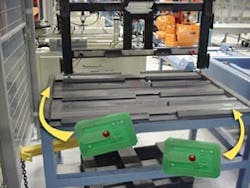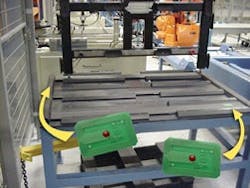Keep track of your pallets with RFID
Think you have pallet-tracking problems? Svenska Retursystem (SRS) distributes more than one million plastic pallets throughout Sweden. Keeping track of each pallet is a formidable, but essential, task. Deposits are required to cover costs should pallets be damaged or lost, and SRS was constantly running into problems with pallets being returned later than expected, or not at all. The outdated inventory system wasn't adequately keeping track of where pallets were being lost or damaged, resulting in SRS incurring the costs.
|
View related content on PlantServices.com |
A system for tracking the pallets while they were in circulation was desperately needed. Bar code technology was proposed, but determined to be insufficient for the application for two reasons. First, because these pallets are for carrying fresh produce, each pallet reentering the facility is treated with a variety of cleaning chemicals and high-pressure washing. Bar codes simply could not endure these conditions. Also, the life of any pallet inevitably involves a significant amount of bumping and bruising, and even a small scratch can render a barcode useless.
Jan-Erik Nilsson, president of EMS RFID AB, a Swedish distributor for Escort Memory Systems (EMS, ems-rfid.com), proposed using 13.56 MHz radio-frequency identification (RFID) to provide real-time visibility of pallets in circulation. Each pallet was outfitted with a tag that would remain with it for its entire lifetime. EMS RFID technology was chosen, most notably because its LRP-P3858 tags can survive the harsh application conditions.
Secreted Identification
The radio-frequency identification (RFID) devices are protected from damage by embedding them in the interior structure of the pallets.
Instead of mounting these tags to the exterior of the pallet (as is necessary with bar codes due to the line-of-sight requirement), engineers at pallet manufacturer Arca System, Perstorp, Sweden, embedded the tags in the interior structure of the two-piece pallet. Two tags are embedded inside opposite corners of the pallets to ensure that regardless of orientation on the conveyer, one tag will be picked up. Once installed, the tags can be written to with information and read by the antenna. When the pallets complete a cycle, the tags are cleared and rewritten.
Two plate antennas at the entrance to the pallet-cleaning machine read the tags. Pallet history is downloaded for each pallet, and if damage is evident, the proper customer is charged. Likewise, the pallets whose origin is unknown can be identified by reading the tags.
Pallets on the road
In this application, pallets leave SRS and arrive at the warehousing hub of a major supermarket. Supermarket operators use a portable handheld scanner to read and write time and date stamp, as well as handling instructions, to the tag. The pallets are then loaded with perishable goods, and the tags are written to with information such as product expiration date and storage instructions. The full pallets are then delivered to the neighborhood grocery store, where grocery workers scan them as they arrive to ensure freshness and quality.
Empty pallets are loaded into the trucks and returned to SRS where they are again read. After relevant charges are processed, pallet information is then cleared, and the tag is written to with date/time information for its next voyage out into the world.
Results of the RFID system are impressive. Each pallet has a self-contained recordkeeping system, eliminating the paperwork that is common with pallet shipments. The combination of resilient RFID tags and reusable pallets is a cost-effective solution: wooden pallets and bar-code labels are both consumables, while plastic pallets and RFID tags are recycled and reused.
By accessing the shipment history of each incoming pallet, SRS is able to recoup for lost and damaged pallets by having record of who was responsible for the product at any given time. Customers pay for the length of time they have the pallets as well, so usage costs can be immediately determined and charged.
Theft, formerly a rampant problem, is greatly reduced with RFID. If a stolen pallet reenters the facility, operators can determine when and where the pallet was taken.

